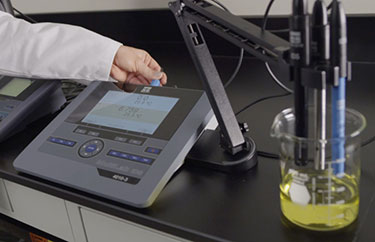pH Electrode Reference Systems
Beyond glass membranes and junctions, pH electrodes differ in reference systems and junction types. The desired application helps determine the choice between pH electrode reference systems and junctions and there are two main quesitons.
1. What is a pH electrode reference system and why do I need it?
2. What kind of reference systems are there for pH electrodes and what features can they provide?
The most common method to obtain a pH measurement is by measuring a voltage. To measure a voltage the pH electrode must be able to measure the difference between two points with different electrical potential values. For a pH electrode to provide a voltage measurement of a solution’s ion concentration, a reference electrode is necessary because its potential essentially remains constant and independent of the solution and temperature relative to the solution being measured.
electrode must be able to measure the difference between two points with different electrical potential values. For a pH electrode to provide a voltage measurement of a solution’s ion concentration, a reference electrode is necessary because its potential essentially remains constant and independent of the solution and temperature relative to the solution being measured.
The pH electrode can then use that reference electrode’s potential to determine how the solution’s ion concentration compares to the reference. The voltage developed from this comparison is then turned into the pH measurement.
The Standard Hydrogen Electrode is used as the international reference system. Unfortunately, due to its complicated handling requirements, it is not typically used for standard applications. A common approved reference system is the Saturated Calomel Electrode, however, this electrode contains mercury and is toxic. The most common reference system is the silver/silver chloride reference system (Ag/AgCl). However, Ag/AgCl can precipitate silver when exposed to certain samples.
An alternate configuration to the standard silver/silver chloride reference system is the double junction system. The double junction construction isolates the Ag/AgCl from the sample by means of a second chamber containing a simple electrolyte solution such as potassium chloride (KCl). A special type of double junction electrode is the Silamid double junction reference system which is a special construction of the Ag/AgCl reference system.
Most electrodes having a Ag/AgCl system are built with a Ag wire coated with AgCl. Silamid reference systems have a glass tube with the inner part coated with Ag, then filled with AgCl, and plugged with polyester fiber.
This reference system creates a greater contact surface area between Ag and AgCl compared to the standard Ag/AgCl wire system. This results in a reference system that is long-lasting and very stable. A more recent reference system is the iodine/iodide system. The iodine/iodide reference system does not precipitate silver and can be used with Tris buffers. The advantages and disadvantages of different reference systems are displayed in the table to the below. Further characteristics of the reference electrode are defined by the junction.
| Reference System |
Advantage |
Disadvantage |
| Ag/AgCl |
Well described, multifunctional, reproducible, wide temperature range, non toxic, environmental sustainability |
Reference potential depends on temperature and could deliver a different potential, if measured at a different temperature as calibrated |
| Hg/Hg2Cl2 (Calomel) |
Stable reference potential |
Toxic, low temperature application ranges 59 to 104 degrees F (15 to 40 degrees C) |
| Tl, Hg/TlCl (Thalamide) |
Very low hysteresis, broad temperature range, low temperature coefficient |
Toxic, out of production |
| Iodine/Iodide |
Low polarization, low temperature dependence, free of undesired heavy metal ions |
Formerly limited long life cycle |
The most important pH electrode reference system is the Ag/AgCl system because it is well described, reproducible, and nontoxic. In the few applications where this reference system does have problems, the newer iodine/iodide reference system can be used instead. Due to an absence of silver ions or other contaminating metal ions the iodine/iodide reference system is an excellent alternative when working with applications requiring rapidly changing temperatures. Even with quick-changing pH values such as titrations, the iodine/iodide reference system is beneficial.
Check out YSI's current laboratory pH instruments, the single-channel MultiLab, the dual-channel MultiLab, and the three-channel MultiLab, in addition to our pH1200 and TruLab.

Additional Blog Posts of Interest:
Why is the pH Scale Logarithmic?
pH Meter Calibration Problems? Check Out These 12 Tips!
Extend the Life of Your pH Electrode in 3 Practical Steps
Is pH the Measurement of Hydrogen Ion Concentration or Ion Activity?